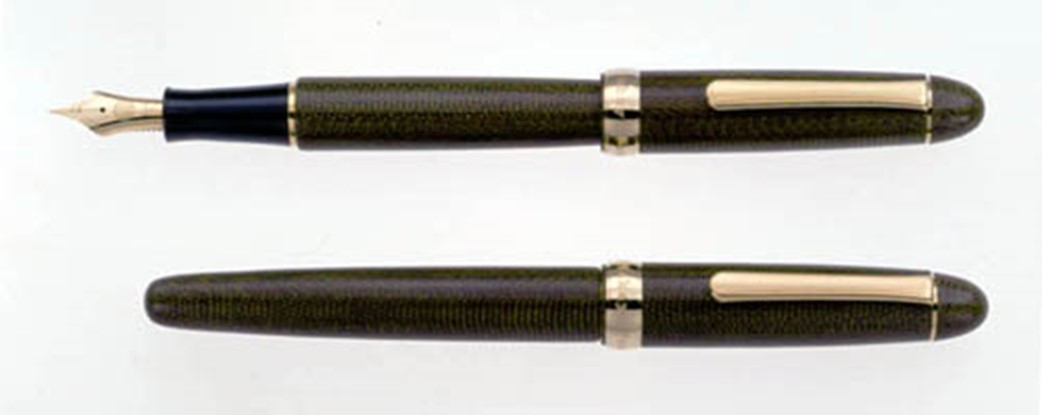Since our founding in 1999, Nakaya Fountain Pen has produced numerous fountain pens, including prototypes. However, some of those fountain pens have been discontinued due to rare materials or because they have been replaced with new products. So, we have decided to introduce some of the fountain pens here.
Unfortunately, the pens listed here are not available now.
■Maki-e・A Cat by Kuniyoshi Utagawa
The motif is an Ukiyo-e, “Cat for mouse repellent” by Kuniyoshi Utagawa. The base color is gold blur from the bottom. The cat is drawn with maki-e technique using white lacquer mixed with palladium powder. A sparrow is drawn on the cap ahead of the cat’s line of sight. Since it uses a transparent barrel and painted with transparent lacquer, you can see the pen nib. A mouse which seems like running into the pen is drawn at the grip section. The base color of the grip section is painted in itame-kinji, the mouse is drawn with tsukegaki technique using black gold. Also, a customer’s precious diamond ring is drawn as a collar of the cat. Even though there are many elements in a pen, such as a diamond, gold base maki-e, transparent painting, and various motifs, the pen became very calm and elegant.

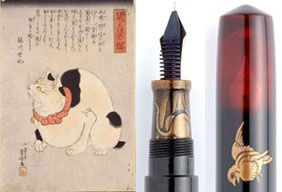
■Sumiko・Hato (Waves)
Firstly, creating big waves with charcoal powders. Then carving delicate waves with the Chin-koku technique. It is possible to express intricate swirls and waves by using very fine blades. The width of each wave line, the spacing between lines, etc., are quite finely finished for a pen shaft with a tight radius.

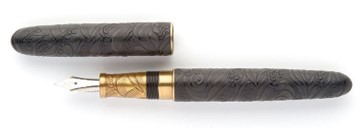
■Maki-e・Origin of Robensugi (Robensugi no Yurai)
The motif is a play picture folding screen (Shibai ebyobu) by Kinzo (Hirose Kinzo, commonly known as Ekin), a famous painter in Kochi. Ryoben was a high priest of Todaiji Temple in the Nara period. He has a legend that he was kidnapped by an eagle when he was two years old and left in a cedar tree in the front of Kasuga Shrine. But he was rescued safely. So, there are many Kabuki plays based on this story.

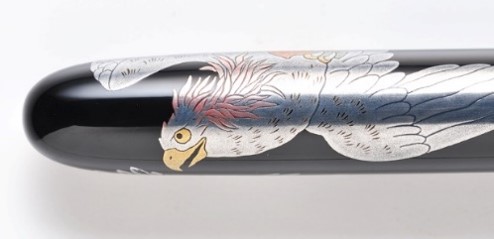
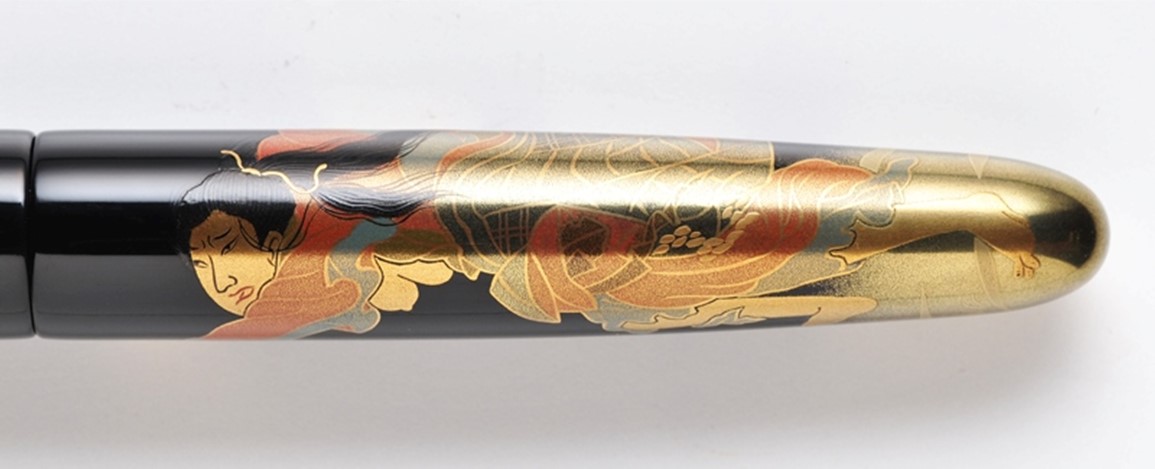
■Qinghai wave finish (Seigaiha)
The lacquer is mixed with egg whites and other substances to create a special strong viscosity, and using a special comb scratching the surface to draw waves. Due to this drawing technique, motif will be slightly different from each other.
Wave patterns are very popular in many designs like “Hato”, the wave created with charcoal powder and whale designs. The technique can create various images by changing the width of the waves.
Wave patterns are very popular in many designs like “Hato”, the wave created with charcoal powder and whale designs. The technique can create various images by changing the width of the waves.

■ Chinkin, Taketorazu(A Tiger and bamboo)
Chin-kin is a technique to carve the Urushi lacquered surface and embedding gold, silver, charcoal, and other colored powders to the line. For this “A tiger and bamboo” motif, some special techniques are used in addition to the general dot carving and line carving. One is a rubbing technique (to scrape the painted surface by rubbing with a chisel), and one is a hair carving technique which can express thin and fluctuating line like real animal hair, is used for tiger hair. The entire body is carved with the hair carving technique. And for eyes, carving circles in the center, putting gold leaves, and carving around the circles with a dot technique.
The line carving technique is used for the tiger beard. The dot carving technique is used for its fangs and tongue. The Single chisel carving technique (a technique in which only one side of a flat chisel is used to create a powerful carving) is used for the bamboo. For the ground, both the rubbing and the dot carving techniques are used. This piece must be the top class of Chinkin works considering the carving techniques used and preciseness.
It is full of techniques such as a very delicate Chinkin technique, blur technique with flat sword like chisel, and so on.
The line carving technique is used for the tiger beard. The dot carving technique is used for its fangs and tongue. The Single chisel carving technique (a technique in which only one side of a flat chisel is used to create a powerful carving) is used for the bamboo. For the ground, both the rubbing and the dot carving techniques are used. This piece must be the top class of Chinkin works considering the carving techniques used and preciseness.
It is full of techniques such as a very delicate Chinkin technique, blur technique with flat sword like chisel, and so on.

■ Iro Chinkin (colored line chinkin), Phoenix and paulownia
Paulownias and a few phoenixes are carved with Chinkin to the kuro-roiro (black Urushi lacquer) base. The line and the dot carving techniques are used. Carving on pen body is really difficult because it is full of curved surfaces and Chinkin cannot start over.

■ Ryukyu Tsuikin・A Flying Dragon
It is a new dragon motif using the Ryukyu (Okinawa) Tsuikin technique. In the 1700’s, the Ryukyu Tsuikin has been developed getting a hint of Tsuishu technique. In Ryukyu Tsuikin technique, mixing pigments into Urushi lacquer to create so called “Mochi”, soft thin Urushi lacquer plate. Then cut and paste the mochi according to the parts of motif. The three-dimensional Urushi on the pen body gives the motif a full of dynamism and reality.

■ Ryukyu Tsuikin・Cherry Blossoms
Cherry blossom is expressed with Ryukyu(Okinawa) Tsuikin technique. The “So-zuke” technique, which is the Tsuikin technique is used for all surfaces, is used.
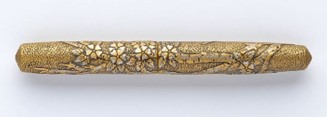
■Briar・Scarlet rose mallow (Hibiscus coccineus)
The flower is expressed with shu (red Urushi) on a gold base, the leaves and bud are in green and greenish yellow Urushi on a gold. Furthermore, “Shuai-urushi” is used to add shades and depths for the motif.
The “Kakiwari” technique is used for express the details of bud. “Raden” is wrapped around the pen body. Because Raden needs thick urushi, it seems rather blackish finish for the first. However, the texture of the briar wood might gradually become visible as aging.
The “Kakiwari” technique is used for express the details of bud. “Raden” is wrapped around the pen body. Because Raden needs thick urushi, it seems rather blackish finish for the first. However, the texture of the briar wood might gradually become visible as aging.

■Briar・A Spider
Draw a spider with the “Taka-Makie” technique on the Fuki-Urushi coating base.

■Briar・Firefly
Draw a firefly with “Taka-Makie” technique on a Fuki-Urushi coating base. The “Raden” and the Gold “Nashiji” are used to express the light of a firefly. The cat rolling-stopper is originally facing upwards, but it is made facing downwards as if the cat looks at the firefly, according to the customer’s request.

■Briar・Marquetry wood patch
Carves the lines resembling cracks and put some clamp of ebonies on it. Because it is just a crack like design, there is no problem with the strength of the pen.

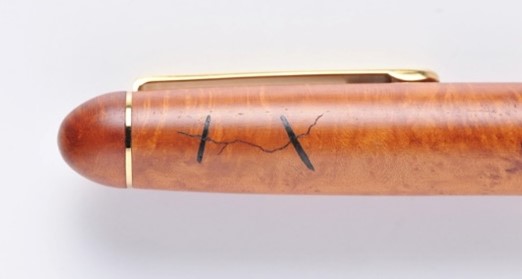
■Botan Karakusa(peony arabesque)
The “Botan Karakusa (Peony arabesque)” is one of the traditional patterns from the ancient times. Many of the “classic patterns” in Japan today were originally from China and further tracing back to the countries of the Silk Road. However, as a result of the Japanese use the patterns frequently for a long time, it has become a Japanese pattern. The “Botan Karakusa (Peony arabesque)” was brought to Japan by envoys to Tang China during the Heian period, and many designs were drawn using the pattern during the Kamakura and Muromachi periods. In addition to being beautiful, it is believed that the pattern has protectional power, the pattern was used for amors decollation.

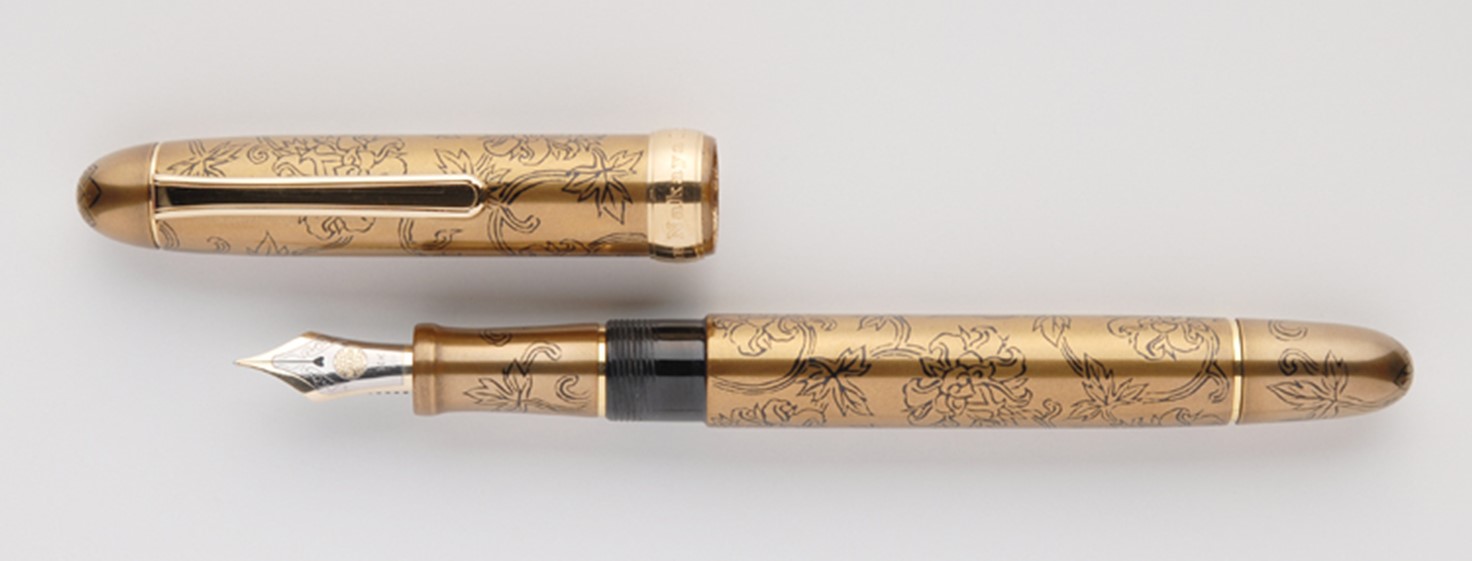
■BIJOUX No.6 World time model
It was created for Jetsetters (who fly around the world on airplanes). A maki-e craftsman applied maki-e to the ebonite shaft, layered lacquer maki-e with silk screen printing, and then applied hand-painted maki-e on top. This is a very elaborate item.
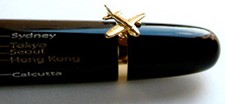

■Art model
It is a painting of acrylic. All of them are painted by hand, so each of them are different.


■”Kanshitsu Togikiri technique”-(Decapod)
Sprinkle colored lacquer powders on the lacquer just the same way as gold powder. Then applying lacquer and it become hardened, polishing the surface. And repeating the process several times to eliminate unevenness and create a smooth surface.

■Equilibrium model
By inserting weights inside the body, it is possible to change the weight and center of gravity of the main body. It is now possible to change the weight by up to 9 grams.

■Carbon Graphite
It is cut from material that has been calcified for 90 days at approximately 3,000°C after solidifying pure carbon at hydraulic pressure of 50,000 tons. Graphite is a type of a carbon material that has a hexagonal grid-like crystalline structure. It is used in our daily life such as the pencil lead and electrode material. It is lighter than aluminum and can withstand most acids and alkalis in a normal temperature.

■Chain armor
Thin silver wire is woven like chain mail and covered the entire pen (Material: 925 sterling silver)

■Silver ripple, red barrel
Each ring is made of sterling silver (925) and finished with brazing. The weight is approximately 50 grams.

■Briar
The cap is a snap type. The briar is made by briar wood. You can see the beauty of the wood grain, and it will give the feeling of “wooden jewel”.

■Standard mode
The cap is a snap type. The whole body is made by ebonite. The color is black only and it has a ring.
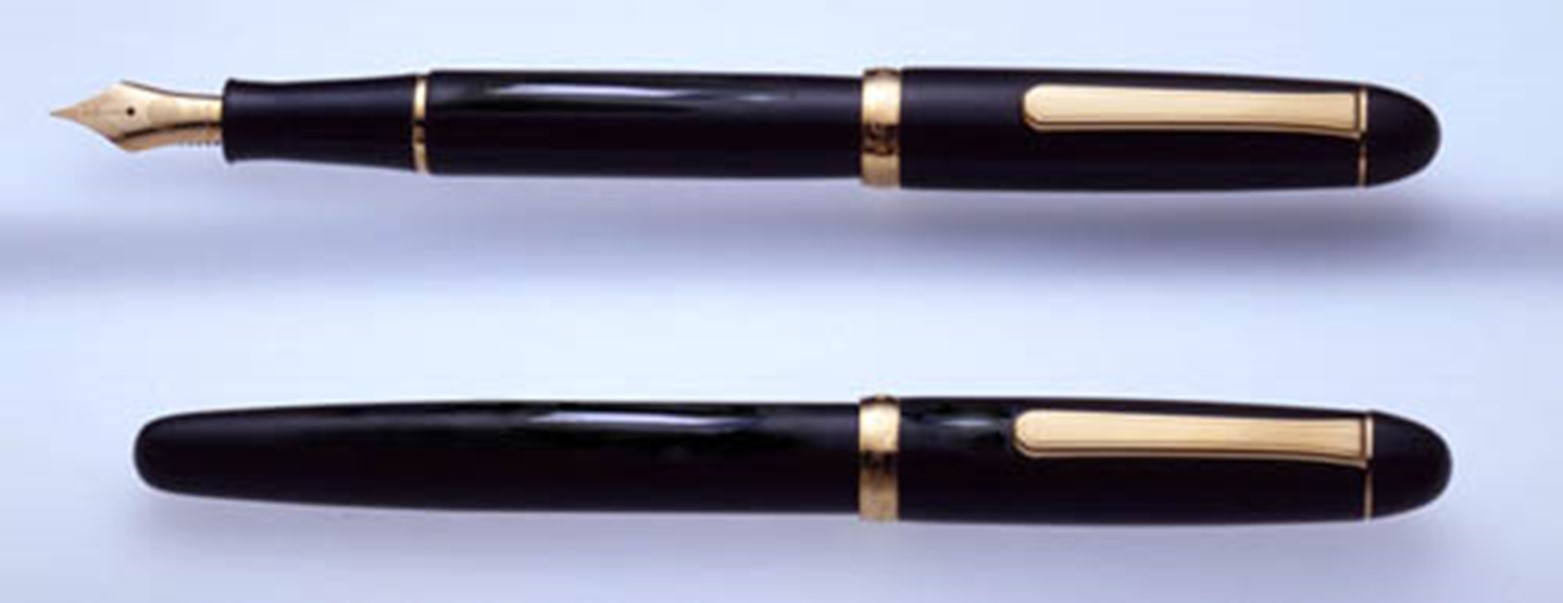
■Special model
The cap is screw type. The whole body is made by ebonite. The color is black only and it has a ring.

■Simple model

■Wine barrel model
Cutting out the oak which is used for long-term aging barrels at famous wineries the wood grain horizontally and molded. The surface is finished with real lacquer to preserve the beauty of the wood grain.
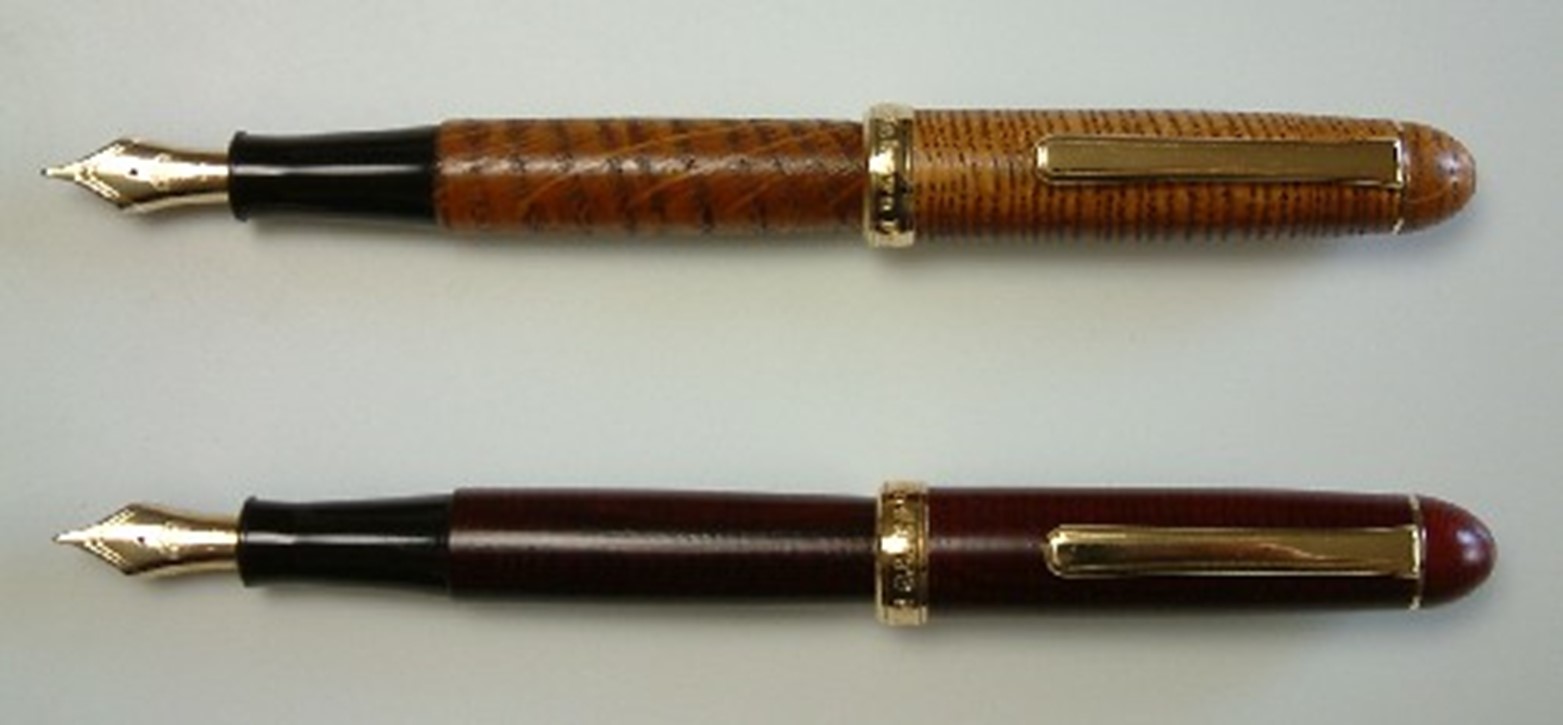
■Canvas Micarta
The material “Canvas Micarta” is made by sandwiching about 40 pieces of canvas fabric per 2cm thickness between phenolic resins, and was developed by an American material manufacturer as a non-slip material for grips on handguns. Currently, it is also used for mountain climbing knives, etc.
